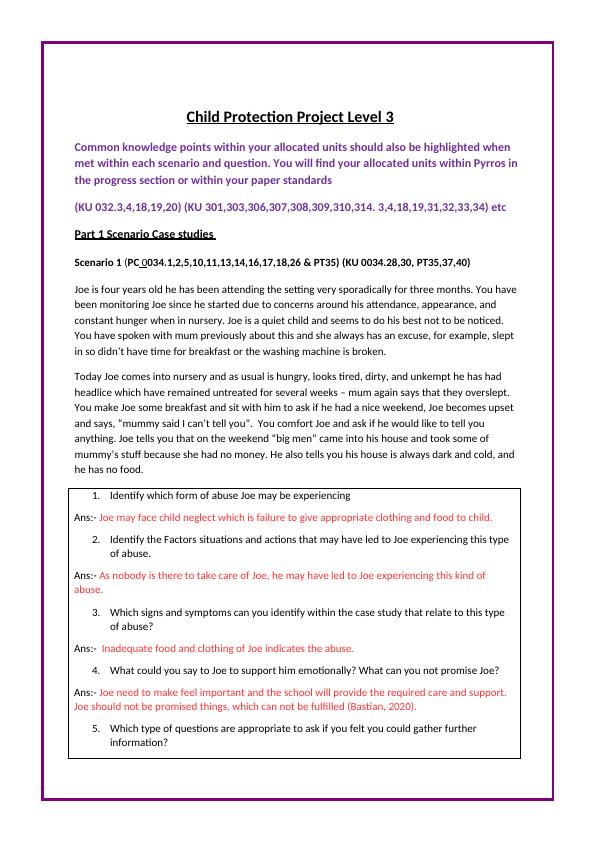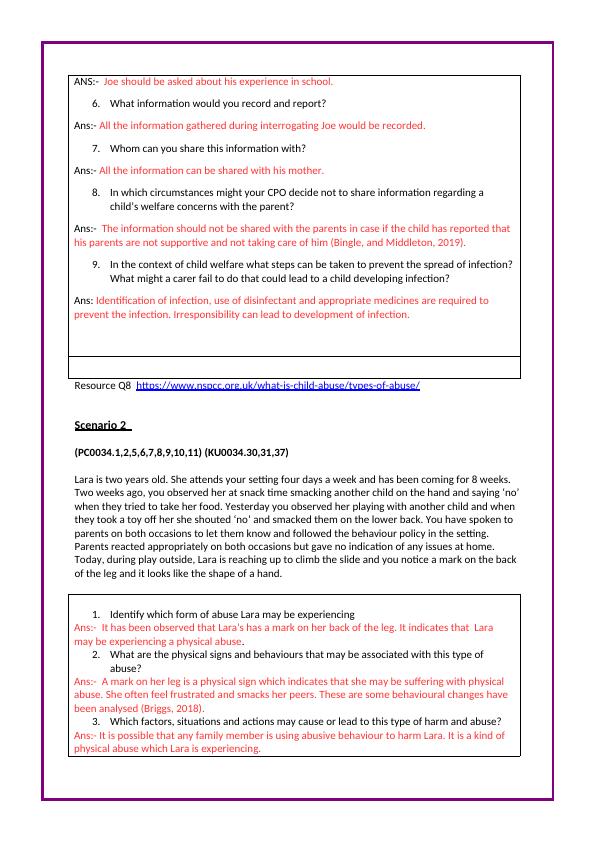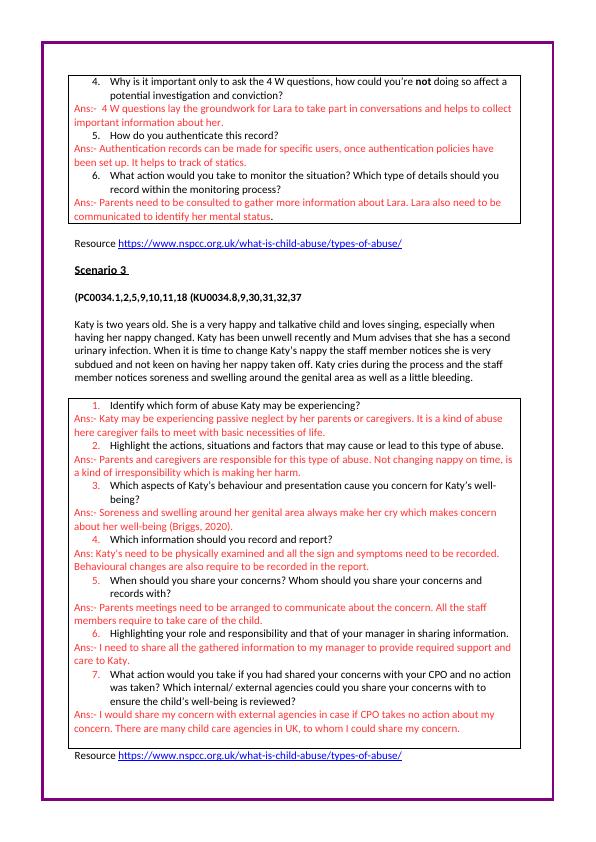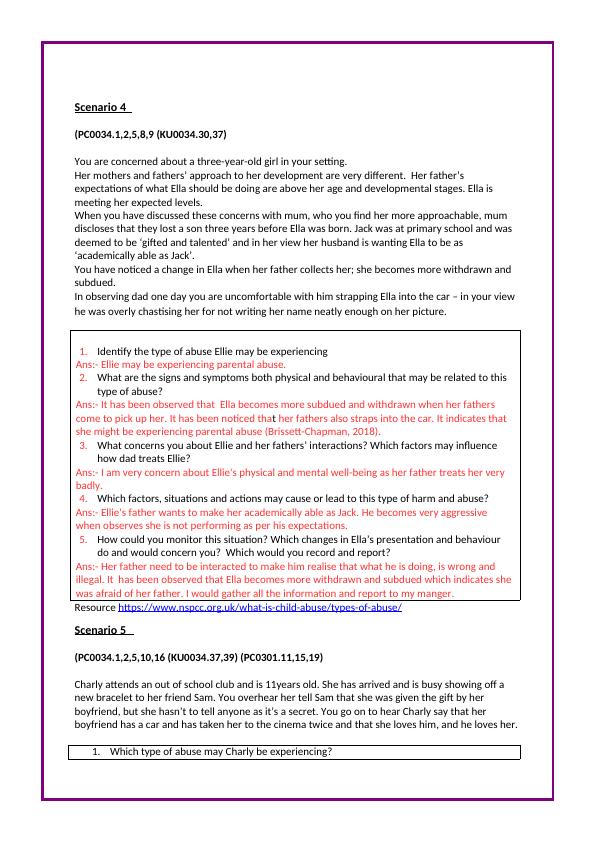Child Protection Project Level 3 - Case Studies and Identifying Abuse
19 Pages8081 Words245 Views
Added on 2023-06-07
About This Document
This article discusses different case studies related to child abuse and how to identify different forms of abuse. It also highlights the signs and symptoms of abuse and how to support emotionally. The article covers topics such as child neglect, physical abuse, passive neglect, parental abuse, and psychological abuse.
Child Protection Project Level 3 - Case Studies and Identifying Abuse
Added on 2023-06-07
ShareRelated Documents
Child Protection Project Level 3
Common knowledge points within your allocated units should also be highlighted when
met within each scenario and question. You will find your allocated units within Pyrros in
the progress section or within your paper standards
(KU 032.3,4,18,19,20) (KU 301,303,306,307,308,309,310,314. 3,4,18,19,31,32,33,34) etc
Part 1 Scenario Case studies
Scenario 1 (PC 0034.1,2,5,10,11,13,14,16,17,18,26 & PT35) (KU 0034.28,30, PT35,37,40)
Joe is four years old he has been attending the setting very sporadically for three months. You have
been monitoring Joe since he started due to concerns around his attendance, appearance, and
constant hunger when in nursery. Joe is a quiet child and seems to do his best not to be noticed.
You have spoken with mum previously about this and she always has an excuse, for example, slept
in so didn’t have time for breakfast or the washing machine is broken.
Today Joe comes into nursery and as usual is hungry, looks tired, dirty, and unkempt he has had
headlice which have remained untreated for several weeks – mum again says that they overslept.
You make Joe some breakfast and sit with him to ask if he had a nice weekend, Joe becomes upset
and says, “mummy said I can’t tell you”. You comfort Joe and ask if he would like to tell you
anything. Joe tells you that on the weekend “big men” came into his house and took some of
mummy’s stuff because she had no money. He also tells you his house is always dark and cold, and
he has no food.
1. Identify which form of abuse Joe may be experiencing
Ans:- Joe may face child neglect which is failure to give appropriate clothing and food to child.
2. Identify the Factors situations and actions that may have led to Joe experiencing this type
of abuse.
Ans:- As nobody is there to take care of Joe, he may have led to Joe experiencing this kind of
abuse.
3. Which signs and symptoms can you identify within the case study that relate to this type
of abuse?
Ans:- Inadequate food and clothing of Joe indicates the abuse.
4. What could you say to Joe to support him emotionally? What can you not promise Joe?
Ans:- Joe need to make feel important and the school will provide the required care and support.
Joe should not be promised things, which can not be fulfilled (Bastian, 2020).
5. Which type of questions are appropriate to ask if you felt you could gather further
information?
Common knowledge points within your allocated units should also be highlighted when
met within each scenario and question. You will find your allocated units within Pyrros in
the progress section or within your paper standards
(KU 032.3,4,18,19,20) (KU 301,303,306,307,308,309,310,314. 3,4,18,19,31,32,33,34) etc
Part 1 Scenario Case studies
Scenario 1 (PC 0034.1,2,5,10,11,13,14,16,17,18,26 & PT35) (KU 0034.28,30, PT35,37,40)
Joe is four years old he has been attending the setting very sporadically for three months. You have
been monitoring Joe since he started due to concerns around his attendance, appearance, and
constant hunger when in nursery. Joe is a quiet child and seems to do his best not to be noticed.
You have spoken with mum previously about this and she always has an excuse, for example, slept
in so didn’t have time for breakfast or the washing machine is broken.
Today Joe comes into nursery and as usual is hungry, looks tired, dirty, and unkempt he has had
headlice which have remained untreated for several weeks – mum again says that they overslept.
You make Joe some breakfast and sit with him to ask if he had a nice weekend, Joe becomes upset
and says, “mummy said I can’t tell you”. You comfort Joe and ask if he would like to tell you
anything. Joe tells you that on the weekend “big men” came into his house and took some of
mummy’s stuff because she had no money. He also tells you his house is always dark and cold, and
he has no food.
1. Identify which form of abuse Joe may be experiencing
Ans:- Joe may face child neglect which is failure to give appropriate clothing and food to child.
2. Identify the Factors situations and actions that may have led to Joe experiencing this type
of abuse.
Ans:- As nobody is there to take care of Joe, he may have led to Joe experiencing this kind of
abuse.
3. Which signs and symptoms can you identify within the case study that relate to this type
of abuse?
Ans:- Inadequate food and clothing of Joe indicates the abuse.
4. What could you say to Joe to support him emotionally? What can you not promise Joe?
Ans:- Joe need to make feel important and the school will provide the required care and support.
Joe should not be promised things, which can not be fulfilled (Bastian, 2020).
5. Which type of questions are appropriate to ask if you felt you could gather further
information?

ANS:- Joe should be asked about his experience in school.
6. What information would you record and report?
Ans:- All the information gathered during interrogating Joe would be recorded.
7. Whom can you share this information with?
Ans:- All the information can be shared with his mother.
8. In which circumstances might your CPO decide not to share information regarding a
child’s welfare concerns with the parent?
Ans:- The information should not be shared with the parents in case if the child has reported that
his parents are not supportive and not taking care of him (Bingle, and Middleton, 2019).
9. In the context of child welfare what steps can be taken to prevent the spread of infection?
What might a carer fail to do that could lead to a child developing infection?
Ans: Identification of infection, use of disinfectant and appropriate medicines are required to
prevent the infection. Irresponsibility can lead to development of infection.
Resource Q8 https://www.nspcc.org.uk/what-is-child-abuse/types-of-abuse/
Scenario 2
(PC0034.1,2,5,6,7,8,9,10,11) (KU0034.30,31,37)
Lara is two years old. She attends your setting four days a week and has been coming for 8 weeks.
Two weeks ago, you observed her at snack time smacking another child on the hand and saying ‘no’
when they tried to take her food. Yesterday you observed her playing with another child and when
they took a toy off her she shouted ‘no’ and smacked them on the lower back. You have spoken to
parents on both occasions to let them know and followed the behaviour policy in the setting.
Parents reacted appropriately on both occasions but gave no indication of any issues at home.
Today, during play outside, Lara is reaching up to climb the slide and you notice a mark on the back
of the leg and it looks like the shape of a hand.
1. Identify which form of abuse Lara may be experiencing
Ans:- It has been observed that Lara's has a mark on her back of the leg. It indicates that Lara
may be experiencing a physical abuse.
2. What are the physical signs and behaviours that may be associated with this type of
abuse?
Ans:- A mark on her leg is a physical sign which indicates that she may be suffering with physical
abuse. She often feel frustrated and smacks her peers. These are some behavioural changes have
been analysed (Briggs, 2018).
3. Which factors, situations and actions may cause or lead to this type of harm and abuse?
Ans:- It is possible that any family member is using abusive behaviour to harm Lara. It is a kind of
physical abuse which Lara is experiencing.
6. What information would you record and report?
Ans:- All the information gathered during interrogating Joe would be recorded.
7. Whom can you share this information with?
Ans:- All the information can be shared with his mother.
8. In which circumstances might your CPO decide not to share information regarding a
child’s welfare concerns with the parent?
Ans:- The information should not be shared with the parents in case if the child has reported that
his parents are not supportive and not taking care of him (Bingle, and Middleton, 2019).
9. In the context of child welfare what steps can be taken to prevent the spread of infection?
What might a carer fail to do that could lead to a child developing infection?
Ans: Identification of infection, use of disinfectant and appropriate medicines are required to
prevent the infection. Irresponsibility can lead to development of infection.
Resource Q8 https://www.nspcc.org.uk/what-is-child-abuse/types-of-abuse/
Scenario 2
(PC0034.1,2,5,6,7,8,9,10,11) (KU0034.30,31,37)
Lara is two years old. She attends your setting four days a week and has been coming for 8 weeks.
Two weeks ago, you observed her at snack time smacking another child on the hand and saying ‘no’
when they tried to take her food. Yesterday you observed her playing with another child and when
they took a toy off her she shouted ‘no’ and smacked them on the lower back. You have spoken to
parents on both occasions to let them know and followed the behaviour policy in the setting.
Parents reacted appropriately on both occasions but gave no indication of any issues at home.
Today, during play outside, Lara is reaching up to climb the slide and you notice a mark on the back
of the leg and it looks like the shape of a hand.
1. Identify which form of abuse Lara may be experiencing
Ans:- It has been observed that Lara's has a mark on her back of the leg. It indicates that Lara
may be experiencing a physical abuse.
2. What are the physical signs and behaviours that may be associated with this type of
abuse?
Ans:- A mark on her leg is a physical sign which indicates that she may be suffering with physical
abuse. She often feel frustrated and smacks her peers. These are some behavioural changes have
been analysed (Briggs, 2018).
3. Which factors, situations and actions may cause or lead to this type of harm and abuse?
Ans:- It is possible that any family member is using abusive behaviour to harm Lara. It is a kind of
physical abuse which Lara is experiencing.

4. Why is it important only to ask the 4 W questions, how could you’re not doing so affect a
potential investigation and conviction?
Ans:- 4 W questions lay the groundwork for Lara to take part in conversations and helps to collect
important information about her.
5. How do you authenticate this record?
Ans:- Authentication records can be made for specific users, once authentication policies have
been set up. It helps to track of statics.
6. What action would you take to monitor the situation? Which type of details should you
record within the monitoring process?
Ans:- Parents need to be consulted to gather more information about Lara. Lara also need to be
communicated to identify her mental status.
Resource https://www.nspcc.org.uk/what-is-child-abuse/types-of-abuse/
Scenario 3
(PC0034.1,2,5,9,10,11,18 (KU0034.8,9,30,31,32,37
Katy is two years old. She is a very happy and talkative child and loves singing, especially when
having her nappy changed. Katy has been unwell recently and Mum advises that she has a second
urinary infection. When it is time to change Katy’s nappy the staff member notices she is very
subdued and not keen on having her nappy taken off. Katy cries during the process and the staff
member notices soreness and swelling around the genital area as well as a little bleeding.
1. Identify which form of abuse Katy may be experiencing?
Ans:- Katy may be experiencing passive neglect by her parents or caregivers. It is a kind of abuse
here caregiver fails to meet with basic necessities of life.
2. Highlight the actions, situations and factors that may cause or lead to this type of abuse.
Ans:- Parents and caregivers are responsible for this type of abuse. Not changing nappy on time, is
a kind of irresponsibility which is making her harm.
3. Which aspects of Katy’s behaviour and presentation cause you concern for Katy’s well-
being?
Ans:- Soreness and swelling around her genital area always make her cry which makes concern
about her well-being (Briggs, 2020).
4. Which information should you record and report?
Ans: Katy's need to be physically examined and all the sign and symptoms need to be recorded.
Behavioural changes are also require to be recorded in the report.
5. When should you share your concerns? Whom should you share your concerns and
records with?
Ans:- Parents meetings need to be arranged to communicate about the concern. All the staff
members require to take care of the child.
6. Highlighting your role and responsibility and that of your manager in sharing information.
Ans:- I need to share all the gathered information to my manager to provide required support and
care to Katy.
7. What action would you take if you had shared your concerns with your CPO and no action
was taken? Which internal/ external agencies could you share your concerns with to
ensure the child’s well-being is reviewed?
Ans:- I would share my concern with external agencies in case if CPO takes no action about my
concern. There are many child care agencies in UK, to whom I could share my concern.
Resource https://www.nspcc.org.uk/what-is-child-abuse/types-of-abuse/
potential investigation and conviction?
Ans:- 4 W questions lay the groundwork for Lara to take part in conversations and helps to collect
important information about her.
5. How do you authenticate this record?
Ans:- Authentication records can be made for specific users, once authentication policies have
been set up. It helps to track of statics.
6. What action would you take to monitor the situation? Which type of details should you
record within the monitoring process?
Ans:- Parents need to be consulted to gather more information about Lara. Lara also need to be
communicated to identify her mental status.
Resource https://www.nspcc.org.uk/what-is-child-abuse/types-of-abuse/
Scenario 3
(PC0034.1,2,5,9,10,11,18 (KU0034.8,9,30,31,32,37
Katy is two years old. She is a very happy and talkative child and loves singing, especially when
having her nappy changed. Katy has been unwell recently and Mum advises that she has a second
urinary infection. When it is time to change Katy’s nappy the staff member notices she is very
subdued and not keen on having her nappy taken off. Katy cries during the process and the staff
member notices soreness and swelling around the genital area as well as a little bleeding.
1. Identify which form of abuse Katy may be experiencing?
Ans:- Katy may be experiencing passive neglect by her parents or caregivers. It is a kind of abuse
here caregiver fails to meet with basic necessities of life.
2. Highlight the actions, situations and factors that may cause or lead to this type of abuse.
Ans:- Parents and caregivers are responsible for this type of abuse. Not changing nappy on time, is
a kind of irresponsibility which is making her harm.
3. Which aspects of Katy’s behaviour and presentation cause you concern for Katy’s well-
being?
Ans:- Soreness and swelling around her genital area always make her cry which makes concern
about her well-being (Briggs, 2020).
4. Which information should you record and report?
Ans: Katy's need to be physically examined and all the sign and symptoms need to be recorded.
Behavioural changes are also require to be recorded in the report.
5. When should you share your concerns? Whom should you share your concerns and
records with?
Ans:- Parents meetings need to be arranged to communicate about the concern. All the staff
members require to take care of the child.
6. Highlighting your role and responsibility and that of your manager in sharing information.
Ans:- I need to share all the gathered information to my manager to provide required support and
care to Katy.
7. What action would you take if you had shared your concerns with your CPO and no action
was taken? Which internal/ external agencies could you share your concerns with to
ensure the child’s well-being is reviewed?
Ans:- I would share my concern with external agencies in case if CPO takes no action about my
concern. There are many child care agencies in UK, to whom I could share my concern.
Resource https://www.nspcc.org.uk/what-is-child-abuse/types-of-abuse/

Scenario 4
(PC0034.1,2,5,8,9 (KU0034.30,37)
You are concerned about a three-year-old girl in your setting.
Her mothers and fathers’ approach to her development are very different. Her father’s
expectations of what Ella should be doing are above her age and developmental stages. Ella is
meeting her expected levels.
When you have discussed these concerns with mum, who you find her more approachable, mum
discloses that they lost a son three years before Ella was born. Jack was at primary school and was
deemed to be ‘gifted and talented’ and in her view her husband is wanting Ella to be as
‘academically able as Jack’.
You have noticed a change in Ella when her father collects her; she becomes more withdrawn and
subdued.
In observing dad one day you are uncomfortable with him strapping Ella into the car – in your view
he was overly chastising her for not writing her name neatly enough on her picture.
1. Identify the type of abuse Ellie may be experiencing
Ans:- Ellie may be experiencing parental abuse.
2. What are the signs and symptoms both physical and behavioural that may be related to this
type of abuse?
Ans:- It has been observed that Ella becomes more subdued and withdrawn when her fathers
come to pick up her. It has been noticed that her fathers also straps into the car. It indicates that
she might be experiencing parental abuse (Brissett-Chapman, 2018).
3. What concerns you about Ellie and her fathers’ interactions? Which factors may influence
how dad treats Ellie?
Ans:- I am very concern about Ellie's physical and mental well-being as her father treats her very
badly.
4. Which factors, situations and actions may cause or lead to this type of harm and abuse?
Ans:- Ellie's father wants to make her academically able as Jack. He becomes very aggressive
when observes she is not performing as per his expectations.
5. How could you monitor this situation? Which changes in Ella’s presentation and behaviour
do and would concern you? Which would you record and report?
Ans:- Her father need to be interacted to make him realise that what he is doing, is wrong and
illegal. It has been observed that Ella becomes more withdrawn and subdued which indicates she
was afraid of her father. I would gather all the information and report to my manger.
Resource https://www.nspcc.org.uk/what-is-child-abuse/types-of-abuse/
Scenario 5
(PC0034.1,2,5,10,16 (KU0034.37,39) (PC0301.11,15,19)
Charly attends an out of school club and is 11years old. She has arrived and is busy showing off a
new bracelet to her friend Sam. You overhear her tell Sam that she was given the gift by her
boyfriend, but she hasn’t to tell anyone as it’s a secret. You go on to hear Charly say that her
boyfriend has a car and has taken her to the cinema twice and that she loves him, and he loves her.
1. Which type of abuse may Charly be experiencing?
(PC0034.1,2,5,8,9 (KU0034.30,37)
You are concerned about a three-year-old girl in your setting.
Her mothers and fathers’ approach to her development are very different. Her father’s
expectations of what Ella should be doing are above her age and developmental stages. Ella is
meeting her expected levels.
When you have discussed these concerns with mum, who you find her more approachable, mum
discloses that they lost a son three years before Ella was born. Jack was at primary school and was
deemed to be ‘gifted and talented’ and in her view her husband is wanting Ella to be as
‘academically able as Jack’.
You have noticed a change in Ella when her father collects her; she becomes more withdrawn and
subdued.
In observing dad one day you are uncomfortable with him strapping Ella into the car – in your view
he was overly chastising her for not writing her name neatly enough on her picture.
1. Identify the type of abuse Ellie may be experiencing
Ans:- Ellie may be experiencing parental abuse.
2. What are the signs and symptoms both physical and behavioural that may be related to this
type of abuse?
Ans:- It has been observed that Ella becomes more subdued and withdrawn when her fathers
come to pick up her. It has been noticed that her fathers also straps into the car. It indicates that
she might be experiencing parental abuse (Brissett-Chapman, 2018).
3. What concerns you about Ellie and her fathers’ interactions? Which factors may influence
how dad treats Ellie?
Ans:- I am very concern about Ellie's physical and mental well-being as her father treats her very
badly.
4. Which factors, situations and actions may cause or lead to this type of harm and abuse?
Ans:- Ellie's father wants to make her academically able as Jack. He becomes very aggressive
when observes she is not performing as per his expectations.
5. How could you monitor this situation? Which changes in Ella’s presentation and behaviour
do and would concern you? Which would you record and report?
Ans:- Her father need to be interacted to make him realise that what he is doing, is wrong and
illegal. It has been observed that Ella becomes more withdrawn and subdued which indicates she
was afraid of her father. I would gather all the information and report to my manger.
Resource https://www.nspcc.org.uk/what-is-child-abuse/types-of-abuse/
Scenario 5
(PC0034.1,2,5,10,16 (KU0034.37,39) (PC0301.11,15,19)
Charly attends an out of school club and is 11years old. She has arrived and is busy showing off a
new bracelet to her friend Sam. You overhear her tell Sam that she was given the gift by her
boyfriend, but she hasn’t to tell anyone as it’s a secret. You go on to hear Charly say that her
boyfriend has a car and has taken her to the cinema twice and that she loves him, and he loves her.
1. Which type of abuse may Charly be experiencing?

End of preview
Want to access all the pages? Upload your documents or become a member.
Related Documents
Case Study of Adam’s Situationlg...
|11
|3175
|269
Dealing with Workplace Discrimination: Strategies and Solutionslg...
|5
|1118
|125
